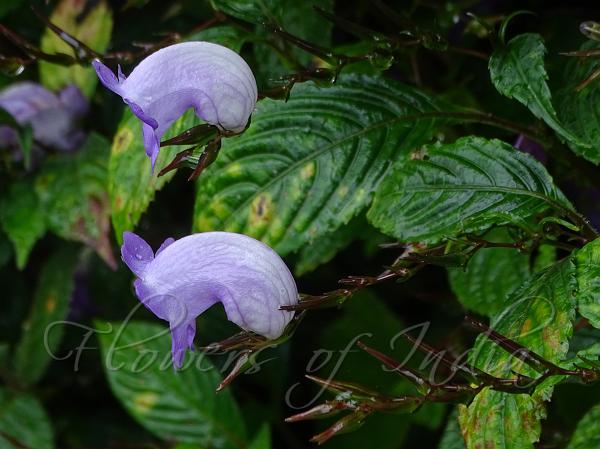|
| Twisted Coneflower |
|

|

| File size | 660672 |
| Original date | 8/20/22 12:37 PM |
| Resolution | 5184 x 3888 |
| Flash | Flash did not fire, auto |
| Focal length | 29.44mm |
| Exposure time | 1/200s |
| Aperture | 4.5 |
| Focus Distance | |
| Metering Mode | Multi-segment |
| Camera make | SONY |
| Camera model | DSC-HX400V |
| Sensor type |
|
|
|
|
Photo: |
Botanical name: Strobilanthes helicta Family: Acanthaceae (Acanthus family)
Synonyms: Asystasia calycina, Ruellia calycina, Pteracanthus calycinus
Synonyms: Asystasia calycina, Ruellia calycina, Pteracanthus calycinus
Twisted Coneflower is a subshrub 50-100 cm tall, with
almost equal-paired leaves. Flowers are white or flushed pale purple,
3.5-4 cm, hairless, tube basally narrow and cylindric for about 5 mm
then abruptly widened to about 1.8 cm and finally narrowed slightly and
bent to about 90 degree near mouth. Petals are oblong, about 5 x 4 mm,
unequal, tip notched. Stamens are 4, not protruding. Sepal-cup is
1.3-2.5 cm, hairless or gland-tipped velvet-hairy, 5-lobed almost to
base; sepals linear with one shorter than others, often keeled, outside
with white cystoliths, tip tapering.
Flowers are borne in leaf-axils, in one-sides spikes, 2-12 cm long,
sometimes few flowered, axis usually strongly zigzag; bracts linear,
5-13 mm, persistent, one of pair per node shorter than other,
bracteoles linear, 2-3 mm. Flowers are 6-10 mm apart on axis, only one
sterile per node. Stems are 4-angled, erect, grooved, usually hairless
but sometimes apically brown velvet-hairy. Leaf-stalks are 0.2-5 cm,
leaf blade ovate-lanceshaped to elliptic, 5-12 x 1-6 cm, both surfaces
hairless, below paler, above dark green, secondary veins 6-7 on each
side of midvein, base narrowed and decurrent onto leaf-stalk, margin
sawtoothed to rarely nearly entire, tip tapering. Capsule is oblong,
1.8-2 cm, hairless, 4-seeded, tip apiculate. Twisted Coneflower is
found in evergreen broad-leaved forests, at altitudes of 1700-2200 m,
in NE India, Bhutan, Myanmar, Nepal and China. Flowering:
August-November.
| Identification credit: Rajib Gogoi | Photographed around Gangtok, Sikkim. |
• Is this flower misidentified? If yes,